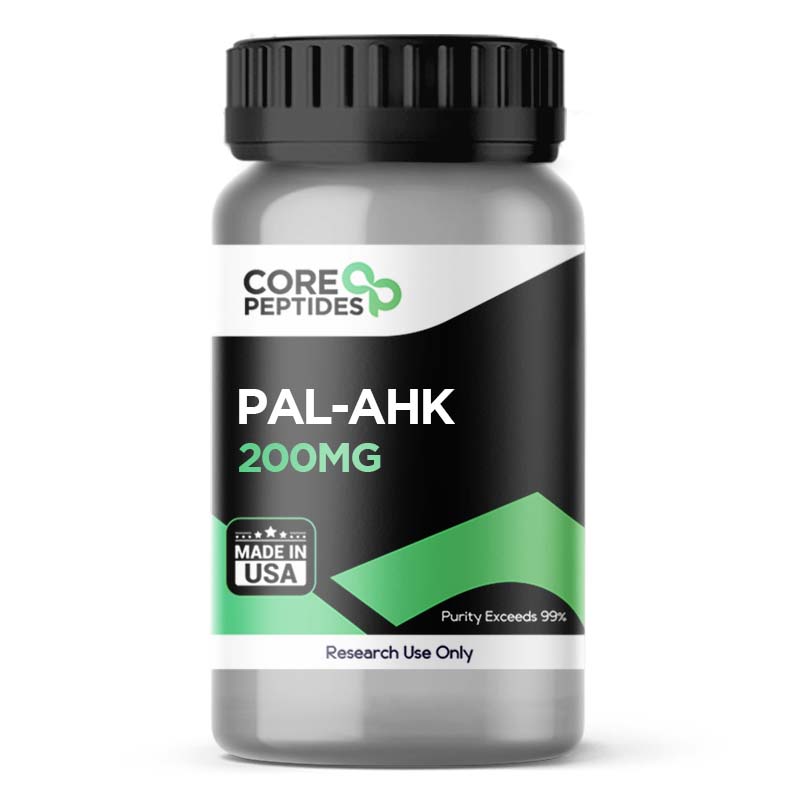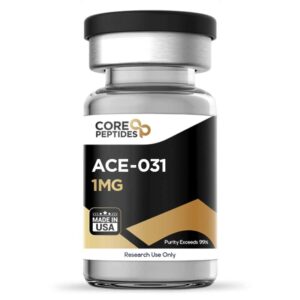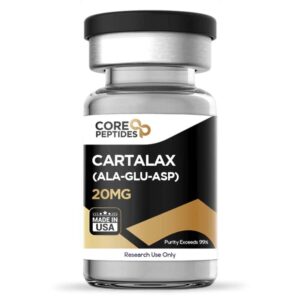Description
Pal-AHK (Palmitoyl-Ala-His-Lys)
Molecular Formula: C₃₁H₅₆N₆O₅
Molecular Weight: 592.8 g/mol
Amino Acid Sequence: Palmitoyl-Alanine-Histidine-Lysine
Other Names: Palmitoyl AHK
Form: Lyophilized powder
Use: Research and laboratory purposes only; not for human consumption
Overview
Pal-AHK is a synthetic palmitoylated tripeptide derived from the AHK sequence (Ala-His-Lys). Palmitoylation enhances cell membrane penetration, improving bioavailability without substantially altering the peptide’s mechanism of action. Research on non-palmitoylated AHK indicates potential benefits in extracellular matrix (ECM) modulation, particularly via collagen and elastin production, which are essential for skin strength, elasticity, and resilience.
Additional potential benefits of Pal-AHK include antioxidative activity and promotion of hair follicle growth, likely mediated through molecular interactions with growth factors, apoptosis regulators, and angiogenesis-related proteins.
Chemical Properties
-
Molecular Formula: C₃₁H₅₆N₆O₅
-
Molecular Weight: 592.8 g/mol
-
Other Names: Palmitoyl AHK
Research and Preclinical Studies
Collagen and Elastin Stimulation
-
Pal-AHK may stimulate dermal fibroblasts to produce collagen type I and elastin, critical for ECM maintenance.
-
Cell culture studies on AHK report up to a 300% increase in collagen type I production compared to controls, suggesting ECM restoration potential.
-
Enhanced collagen and elastin may improve skin elasticity, thickness, and structural integrity, supporting anti-aging outcomes.
Antioxidative Properties
-
Pal-AHK may scavenge free radicals, reducing oxidative stress in dermal cells.
-
By mitigating oxidative damage, Pal-AHK could limit wrinkle formation and support cell viability, enhancing skin barrier resilience.
-
Studies indicate that AHK may reduce TGF-β1 expression, which can regulate inflammation and extracellular matrix turnover, potentially preventing chronic inflammation-related tissue damage.
Hair Growth Potential
-
Though Pal-AHK-specific studies are limited, AHK derivatives have shown the ability to:
-
Stimulate dermal papilla cell (DPC) proliferation
-
Increase the Bcl-2/Bax ratio, promoting anti-apoptotic activity
-
Reduce cleaved caspase-3 and PARP, decreasing programmed cell death in hair follicles
-
Enhance VEGF expression, supporting angiogenesis and follicle nutrient supply
-
-
These mechanisms suggest that Pal-AHK may create a favorable environment for hair retention and growth.
Skin Cell Viability and ECM Modulation
-
Pal-AHK may enhance dermal fibroblast proliferation and collagen synthesis, directly impacting ECM renewal.
-
By promoting dermal cell growth and viability, the peptide could strengthen the dermal-epidermal junction, improving overall skin integrity and repair capacity.
Potential Applications
-
Skin anti-aging formulations targeting wrinkle reduction, elasticity restoration, and ECM integrity
-
Hair growth-supporting products, potentially enhancing follicle survival and angiogenesis
-
Dermal tissue repair and antioxidant support in research settings
Conclusion
Pal-AHK is a palmitoylated AHK tripeptide with promising preclinical evidence suggesting it can:
-
Stimulate collagen and elastin production for ECM support
-
Exhibit antioxidative activity, protecting against oxidative stress
-
Promote hair follicle health via apoptosis modulation and VEGF upregulation
-
Enhance dermal fibroblast proliferation, potentially improving skin repair
It is strictly available for research purposes only, with efficacy primarily demonstrated in preclinical and in vitro studies.
References
-
Tsuge, N., Eikawa, Y., Nomura, Y., et al. (1991). The anti-oxidative activity of peptides prepared by enzymatic hydrolysis of egg-white albumin. Journal of the Agricultural Chemical Society of Japan.
-
Shimura, H., Tanaka, R., Shimada, Y., et al. (2017). Glycyl-alanyl-histidine protects PC12 cells against hydrogen peroxide toxicity. BMC Biochemistry, 18(1), 14. doi:10.1186/s12858-017-0089-x
-
Nirmal, B. (2018). IADVL Textbook of Trichology, 163.
-
Kecel-Gunduza, S., et al. (2020). In silico analysis for characterizing the structure and binding properties of Ala-His-Lys (AHK) tripeptide. The Online Journal of Science and Technology, 10(3).
-
Pyo, H.K., et al. (2007). The effect of tripeptide-copper complex on human hair growth in vitro. Archives of Pharmacal Research, 30(7), 834–839. doi:10.1007/BF02978833
-
Anastassakis, K. (2022). Copper Tripeptides. In: Androgenetic Alopecia From A to Z: Vol. 2 Drugs, Herbs, Nutrition and Supplements. Cham: Springer International Publishing.
-





Reviews
There are no reviews yet.